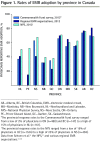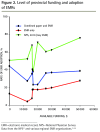Progress in electronic medical record adoption in Canada
- PMID: 27035020
- PMCID: PMC4677946
Progress in electronic medical record adoption in Canada
Abstract
Objective: To determine the rate of adoption of electronic medical records (EMRs) by physicians across Canada, provincial incentives, and perceived benefits of and barriers to EMR adoption.
Data sources: Data on EMR adoption in Canada were collected from CINAHL, MEDLINE, PubMed, EMBASE, the Cochrane Library, the Health Council of Canada, Canada Health Infoway, government websites, regional EMR associations, and health professional association websites.
Study selection: After removal of duplicate articles, 236 documents were found matching the original search. After using the filter Canada, 12 documents remained. Additional documents were obtained from each province's EMR website and from the Canada Health Infoway website.
Synthesis: Since 2006, Canadian EMR adoption rates have increased from about 20% of practitioners to an estimated 62% of practitioners in 2013, with substantial regional disparities ranging from roughly 40% of physicians in New Brunswick and Quebec to more than 75% of physicians in Alberta. Provincial incentives vary widely but appear to have only a weak relationship with the rate of adoption. Many adopters use only a fraction of their software's available functions. User-cited benefits to adoption include time savings, improved record keeping, heightened patient safety, and confidence in retrieved data when EMRs are used efficiently. Barriers to adoption include financial and time constraints, lack of knowledgeable support personnel, and lack of interoperability with hospital and pharmacy systems.
Conclusion: Canadian physicians remain at the stage of EMR adoption. Progression in EMR use requires experienced, knowledgeable technical support during implementation, and financial support for the transcription of patient data from paper to electronic media. The interoperability of EMR offerings for hospitals, pharmacies, and clinics is the rate-limiting factor in achieving a unified EMR solution for Canada.
Objectif: Déterminer le taux d’adoption par les médecins canadiens du dossier médical électronique (DME), les mesures incitatives provinciales, mais aussi les avantages perçus au DME et les obstacles qui ralentissent son adoption.
Sources des données: Les données concernant l’adoption du DME au Canada proviennent des bases de données CINAHL, MEDLINE, PubMed, Embase, Cochrane Library, du Conseil canadien de la santé, de l’Inforoute Santé du Canada, de sites Web du gouvernement, d’associations régionales pour le DME et de sites Web d’associations de professionnels de la santé.
Choix des études: Après avoir éliminé les duplicatas d’articles, on a retenu 236 documents qui correspondaient à la recherche initiale. Après utilisation du filtre Canada, il en restait 12. Des documents additionnels ont été tirés des sites Web traitant du DME de chacune des provinces et de celui de l’Inforoute Santé du Canada.
Synthèse: Depuis 2006, le taux d’adoption du DME par les médecins canadiens a augmenté, passant d’environ 20 % à environ 62 % en 2013, avec toutefois des disparités régionales importantes, les taux variant entre environ 40 % au Nouveau-Brunswick et au Québec, et plus de 75 % en Alberta. Les mesures incitatives provinciales varient considérablement, mais semblent n’avoir qu’une faible relation avec le taux d’adoption. Plusieurs de ceux qui adoptent le DME n’utilisent qu’une fraction des fonctions disponibles de leur logiciel. Parmi les avantages du DME que mentionnent les utilisateurs, citons les gains de temps, une meilleure conservation des dossiers, une sécurité améliorée pour le patient et une meilleure confiance dans les données lorsque le DME est utilisé correctement. Les facteurs qui ralentissent l’adoption du DME incluent les contraintes de temps et de financement, le peu d’appui d’un personnel compétent et le manque d’interopérabilité avec les systèmes existant dans les hôpitaux et les pharmacies.
Conclusion: Au Canada, les médecins en sont encore au stade de l’adoption du DME. La progression dans l’utilisation du DME requiert un soutien technique expérimenté et compétent durant la période d’adoption et un soutien financier pour la transcription des données du papier au support électronique. Enfin, l’interopérabilité du DME avec les hôpitaux, les pharmacies et les cliniques est le facteur principal qui limite l’atteinte d’une solution uniforme pour l’ensemble du Canada.
Figures


Similar articles
-
The trends in EMR and CPOE adoption in Japan under the national strategy.Int J Med Inform. 2013 Oct;82(10):1004-11. doi: 10.1016/j.ijmedinf.2013.07.004. Epub 2013 Aug 9. Int J Med Inform. 2013. PMID: 23932755
-
Barriers to organizational adoption of EMR systems in family physician practices: a mixed-methods study in Canada.Int J Med Inform. 2014 Aug;83(8):548-58. doi: 10.1016/j.ijmedinf.2014.06.003. Epub 2014 Jun 7. Int J Med Inform. 2014. PMID: 24969270
-
Barriers to electronic medical record implementation: a comparison between ophthalmology and other surgical specialties in Canada.Can J Ophthalmol. 2017 Oct;52(5):503-507. doi: 10.1016/j.jcjo.2017.02.018. Epub 2017 Apr 20. Can J Ophthalmol. 2017. PMID: 28985812
-
A review of electronic medical record keeping on mobile medical service trips in austere settings.Int J Med Inform. 2017 Feb;98:33-40. doi: 10.1016/j.ijmedinf.2016.11.008. Epub 2016 Nov 30. Int J Med Inform. 2017. PMID: 28034410 Review.
-
Factors affecting the mature use of electronic medical records by primary care physicians: a systematic review.BMC Med Inform Decis Mak. 2021 Feb 19;21(1):67. doi: 10.1186/s12911-021-01434-9. BMC Med Inform Decis Mak. 2021. PMID: 33607986 Free PMC article.
Cited by
-
Strategies for working across Canadian practice-based research and learning networks (PBRLNs) in primary care: focus on frailty.BMC Fam Pract. 2021 Nov 12;22(1):220. doi: 10.1186/s12875-021-01573-y. BMC Fam Pract. 2021. PMID: 34772356 Free PMC article.
-
An overview of clinical decision support systems: benefits, risks, and strategies for success.NPJ Digit Med. 2020 Feb 6;3:17. doi: 10.1038/s41746-020-0221-y. eCollection 2020. NPJ Digit Med. 2020. PMID: 32047862 Free PMC article. Review.
-
The current and potential uses of Electronic Medical Record (EMR) data for primary health care performance measurement in the Canadian context: a qualitative analysis.BMC Health Serv Res. 2021 Aug 15;21(1):820. doi: 10.1186/s12913-021-06851-0. BMC Health Serv Res. 2021. PMID: 34392832 Free PMC article.
-
Potential Factors Influencing Adoption of a Primary Care Pathway to Prevent Functional Decline in Older Adults.Can Geriatr J. 2023 Jun 1;26(2):227-238. doi: 10.5770/cgj.26.646. eCollection 2023 Jun. Can Geriatr J. 2023. PMID: 37265986 Free PMC article.
-
Level of Digitization in Dutch Hospitals and the Lengths of Stay of Patients with Colorectal Cancer.J Med Syst. 2017 May;41(5):84. doi: 10.1007/s10916-017-0734-3. Epub 2017 Apr 8. J Med Syst. 2017. PMID: 28391455 Free PMC article.
References
-
- Canada Health Infoway The emerging benefits of electronic medical record use in community-based care. Toronto, ON: Health Canada Infoway; 2013. Available from: https://www.infoway-inforoute.ca/en/component/edocman/1225-the-emerging-... Accessed 2015 Oct 27.
-
- Häyrinen K, Saranto K, Nykanen P. Definition, structure, content, use and impacts of electronic health records: a review of the research literature. Int J Med Inform 2008;77(5):291–304. Epub 2007 Oct 22. - PubMed
-
- Canada Health Infoway EMR, EHR, and PHR—why all the confusion? Toronto, ON: Health Canada Infoway; 2013. Available from: http://infowayconnects.infoway-inforoute.ca/2011/04/07/emr-ehr-and-phr-w... Accessed 2015 Oct 27.
-
- Buntin MB, Jain SH, Blumenthal D. Health information technology: laying the infrastructure for national health reform. Health Aff (Millwood) 2010;29(6):1214–9. - PubMed
-
- Healthcare Information and Management Systems Society Defining and testing EMR usability: principles and proposed methods of EMR usability evaluation and rating. Chicago, IL: Healthcare Information and Management Systems Society; 2013. Available from: www.himss.org/ResourceLibrary/GenResourceDetail.aspx?ItemNumber=39192 Accessed 2015 Oct 27.
MeSH terms
LinkOut - more resources
Full Text Sources
